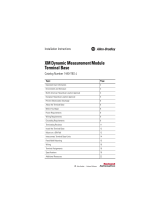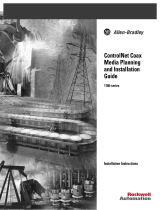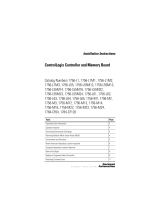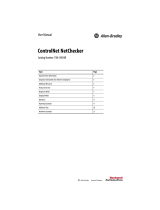Page is loading ...

ControlNet
Universal PCI
Communication
Interface Card
1784-PCIC, 1784-PCICS
Series B
Installation
Instructions

Important User Information
Solid state equipment has operational characteristics differing from those of electromechanical equipment.
Safety Guidelines for the Application, Installation and Maintenance of Solid State Controls (Publication
SGI-1.1, available from your local Rockwell Automation sales office or online at
http://www.literature.rockwellautomation.com) describes some important differences between solid state
equipment and hard-wired electromechanical devices. Because of this difference, and also because of the
wide variety of uses for solid state equipment, all persons responsible for applying this equipment must
satisfy themselves that each intended application of this equipment is acceptable.
In no event will Rockwell Automation, Inc. be responsible or liable for indirect or consequential damages
resulting from the use or application of this equipment.
The examples and diagrams in this manual are included solely for illustrative purposes. Because of the many
variables and requirements associated with any particular installation, Rockwell Automation, Inc. cannot
assume responsibility or liability for actual use based on the examples and diagrams.
No patent liability is assumed by Rockwell Automation, Inc. with respect to use of information, circuits,
equipment, or software described in this manual.
Reproduction of the contents of this manual, in whole or in part, without written permission of Rockwell
Automation, Inc. is prohibited.
Throughout this manual we use notes to make you aware of safety considerations.
WARNING
Identifies information about practices or circumstances that can cause an explosion in a
hazardous environment, which may lead to personal injury or death, property damage,
or economic loss.
IMPORTANT
Identifies information that is critical for successful application and understanding of the
product.
ATTENTION
Identifies information about practices or circumstances that can lead to personal injury
or death, property damage, or economic loss. Attentions help you:
• identify a hazard
• avoid a hazard
• recognize the consequence
SHOCK HAZARD
Labels may be located on or inside the drive to alert people that dangerous voltage may
be present.
BURN HAZARD
Labels may be located on or inside the drive to alert people that surfaces may be
dangerous temperatures.

Publication 1784-IN003D-EN-P - January 2006
Table of Contents
Chapter 1
Install the 1784-PCIC or 1784-PCICS Communication Interface
Card
European Hazardous Location Approval (1784-PCIC only) . . . . . 1-3
European Zone 2 Certification. . . . . . . . . . . . . . . . . . . . . . . 1-3
North American Hazardous Location Approval . . . . . . . . . . . . . 1-4
Access the Computer’s PCI Local Bus Expansion Slots . . . . . . . . 1-5
Insert the Card Into the Computer. . . . . . . . . . . . . . . . . . . . . . . 1-6
Connect to the Network . . . . . . . . . . . . . . . . . . . . . . . . . . . . . . 1-7
Connect the Card Directly to the ControlNet Network . . . . . . . . 1-9
Connect to a Device on the ControlNet Network . . . . . . . . . . . 1-10
Chapter 2
Install the Driver in Windows XP
Install the Driver in Windows XP for the First Time . . . . . . . . . 2-1
Update the Existing Driver in Windows XP . . . . . . . . . . . . . . . . 2-3
Chapter 3
Install the Driver in Windows 2000
Install the Driver in Windows 2000 for the First Time. . . . . . . . . 3-1
Update the Existing Driver in Windows 2000. . . . . . . . . . . . . . . 3-4
Chapter 4
Install the Driver in Windows 98/Me
Install the Driver in Windows 98/Me for the First Time . . . . . . . 4-1
Install the Virtual Backplane Driver. . . . . . . . . . . . . . . . . . . . . . 4-3
Update the Existing Driver in Windows 98/Me . . . . . . . . . . . . . 4-5

ii Table of Contents
Publication 1784-IN003D-EN-P - January 2006
Chapter 5
Once You Have Completed the Installation
Register the EDS File . . . . . . . . . . . . . . . . . . . . . . . . . . . . . . . . 5-1
Configure the ControlNet Communications Driver
in RSLinx Software . . . . . . . . . . . . . . . . . . . . . . . . . . . . . . . . . . 5-2
Connect a SoftLogix Controller to the ControlNet Network . . . . . 5-4
Go Online With RSNetWorx for ControlNet Software . . . . . . . . . 5-7
Chapter 6
Interpret the LED Indicators
Chapter 7
Specifications
Index

Publication 1784-IN003D-EN-P - January 2006
Chapter
1
Install the 1784-PCIC or 1784-PCICS
Communication Interface Card
Before you install the card, be certain that you:
• know how to install hardware in your computer.
• consult your computer’s documentation for hardware installation
instructions.
Refer to the following publications for more information:
• ControlNet Coax Media Planning and Installation, publication CNET-IN002
• ControlNet Communication Modules in Logix5000 Control Systems,
publication CNET-UM001
• SoftLogix5800 System User Manual, publication 1789-UM002
For Information On This Topic See Page
Access the Computer’s PCI Local Bus Expansion Slots 1-5
Insert the Card Into the Computer 1-6
Connect to the Network 1-7
Connect the Card Directly to the ControlNet Network 1-9
Connect to a Device on the ControlNet Network 1-10
TIP
Installation instructions for both the 1784-PCIC and 1784-PCICS
cards are exactly the same. In most illustrations, the 1784-PCIC
card is shown.

1-2 Install the 1784-PCIC or 1784-PCICS Communication Interface Card
Publication 1784-IN003D-EN-P - January 2006
ATTENTION
This equipment is intended for use in a Pollution Degree 2
industrial environment, in overvoltage Category II applications (as
defined in IEC publication 60664-1), at altitudes up to 2000 meters
without derating.
This equipment is considered Group 1, Class A industrial
equipment according to IEC/CISPR Publication 11. Without
appropriate precautions, there may be potential difficulties
ensuring electromagnetic compatibility in other environments due
to conducted as well as radiated disturbance.
This equipment is supplied as open type equipment. It must be
mounted within an enclosure that is suitably designed for those
specific environmental conditions that will be present and
appropriately designed to prevent personal injury resulting from
accessibility to live parts. The interior of the enclosure must be
accessible only by the use of a tool. Subsequent sections of this
publication may contain additional information regarding specific
enclosure type ratings that are required to comply with certain
product safety certifications.
NOTE: See NEMA Standards publication 250 and IEC publication
60529, as applicable, for explanations of the degrees of protection
provided by different types of enclosure. Also, see the appropriate
sections in this publication, as well as the Industrial Automation
Wiring and Grounding Guidelines, Allen-Bradley publication
1770-4.1, for additional installation requirements pertaining to this
equipment.
ATTENTION
Prevent Electrostatic Discharge
This equipment is sensitive to electrostatic discharge, which can
cause internal damage and affect normal operation. Follow these
guidelines when you handle this equipment:
• Touch a grounded object to discharge potential static
• Wear an approved grounding wriststrap
• Do not touch connectors or pins on component boards
• Do not touch circuit components inside the equipment
• Use a static-safe workstation, if available
• Store the equipment in appropriate static-safe packaging
when not in use.

Install the 1784-PCIC or 1784-PCICS Communication Interface Card 1-3
Publication 1784-IN003D-EN-P - January 2006
European Hazardous Location Approval (1784-PCIC only)
European Zone 2 Certification
The following applies when the product bears the EEx Marking:
This equipment is intended for use in potentially explosive atmospheres as defined
by European Union Directive 94/9/EC.
The LCIE (Laboratoire Central des Industries Electriques) certifies that this
equipment has been found to comply with the Essential Health and Safety
Requirements relating to the design and construction of Category 3 equipment
intended for use in potentially explosive atmospheres, given in Annex II to this
Directive. The examination and test results are recorded in confidential report No.
28 682 010.
Compliance with the Essential Health and Safety Requirements has been assured by
compliance with EN 50021.
IMPORTANT
This equipment is not resistant to sunlight or other sources of UV
radiation.
The secondary of a current transformer shall not be open-circuited
when applied in Class I, Zone 2 environments.
Equipment of lesser Enclosure Type Rating must be installed in an
enclosure providing at least IP54 protection when applied in Class
I, Zone 2 environments.
This equipment shall be used within its specified ratings defined
by Allen-Bradley.
Provision shall be made to prevent the rated voltage from being
exceeded by transient disturbances of more than 40% when
applied in Class I, Zone 2 environments.

1-4 Install the 1784-PCIC or 1784-PCICS Communication Interface Card
Publication 1784-IN003D-EN-P - January 2006
North American Hazardous Location Approval
The following information applies when
operating this equipment in hazardous
locations:
Informations sur l’utilisation de cet équipement en
environnements dangereux:
Products marked CL I, DIV 2, GP A, B, C, D are suitable
for use in Class I Division 2 Groups A, B, C, D,
Hazardous Locations and nonhazardous locations only.
Each product is supplied with markings on the rating
nameplate indicating the hazardous location
temperature code. When combining products within a
system, the most adverse temperature code (lowest T
number) may be used to help determine the overall
temperature code of the system. Combinations of
equipment in your system are subject to investigation
by the local Authority Having Jurisdiction at the time
of installation.
Les produits marqués CL I, DIV 2, GP A, B, C, D ne
conviennent qu’à une utilisation en environnements de
Classe I Division 2 Groupes A, B, C, D dangereux et non
dangereux. Chaque produit est livré avec des marquages
sur sa plaque d’identification qui indiquent le code de
température pour les environnements dangereux.
Lorsque plusieurs produits sont combinés dans un
système, le code de température le plus défavorable
(code de température le plus faible) peut être utilisé pour
déterminer le code de température global du système.
Les combinaisons d’équipements dans le système sont
sujettes à inspection par les autorités locales qualifiées
au moment de l’installation.
WARNING
EXPLOSION HAZARD
• Do not disconnect equipment
unless power has been
removed or the area is known
to be nonhazardous.
• Do not disconnect
connections to this
equipment unless power has
been removed or the area is
known to be nonhazardous.
Secure any external
connections that mate to this
equipment by using screws,
sliding latches, threaded
connectors, or other means
provided with this product.
• Substitution of components
may impair suitability for
Class I, Division 2.
• If this product contains
batteries, they must be
changed only in an area
known to be nonhazardous.
AVERTISSEMENT
RISQUE D’EXPLOSION
• Couper le courant ou
s’assurer que
l’environnement est
classé non dangereux
avant de débrancher
l'équipement.
• Couper le courant ou
s'assurer que
l’environnement est
classé non dangereux
avant de débrancher les
connecteurs. Fixer tous
les connecteurs externes
reliés à cet équipement à
l'aide de vis, loquets
coulissants, connecteurs
filetés ou autres moyens
fournis avec ce produit.
• La substitution de
composants peut rendre
cet équipement inadapté
à une utilisation en
environnement de Classe
I, Division 2.
• S’assurer que
l’environnement est
classé non dangereux
avant de changer les
piles.

Install the 1784-PCIC or 1784-PCICS Communication Interface Card 1-5
Publication 1784-IN003D-EN-P - January 2006
To install the card, you need to:
• access the computer’s expansion slots.
• insert the card into the computer.
Access the Computer’s PCI Local Bus Expansion Slots
To install the card, you must access the computer’s PCI local bus expansion slots.
Follow these general steps, or refer to your computer’s user guide for further
instructions.
1. Shut down the host computer.
2. Remove the computer’s cover.
3. Select a vacant PCI local bus expansion slot.
4. Loosen the screw (if present) on the back (rear bracket) of the computer.
5. Remove the slot’s expansion cover.
IMPORTANT
The card’s dimensions are shown below.
4.2 in.
10.7 cm
6.5 in.
16.5 cm
31474-M

1-6 Install the 1784-PCIC or 1784-PCICS Communication Interface Card
Publication 1784-IN003D-EN-P - January 2006
Insert the Card Into the Computer
1. Handle the card so that you prevent electrostatic discharge.
Refer to the Preface of this manual for more information.
2. Insert the card into the edge connector and tighten the expansion slot screw
(if present).
3. Replace the computer cover.
4. Turn on the computer to be certain that it comes up correctly.
WARNING
When used in a Class I, Division 2, hazardous location,
this equipment must be mounted in a suitable enclosure
with proper wiring method that complies with the
governing electrical codes.
If you insert or remove the card while host power is on,
an electrical arc can occur. This could cause an
explosion in hazardous location installations.
Be sure that power is removed or the area is
nonhazardous before proceeding.
If the Computer Then
Turns on Go to to the next section, Connect to the Network
Hangs up Either the card is not seated correctly in the PCI slot or you have a
memory or I/O conflict. You should:
• remove and reinsert the card into the same PCI slot and
try again
• remove and reinsert the card into a different PCI slot and
try again
• remove all other non-essential cards and try again
If you continue to experience difficulty, contact your local
Rockwell Automation sales representative or distributor, or call
Rockwell Automation Technical Support at 440.646.5800.

Install the 1784-PCIC or 1784-PCICS Communication Interface Card 1-7
Publication 1784-IN003D-EN-P - January 2006
Connect to the Network
After you have installed the card, you can connect it:
• directly to a ControlNet network, which requires a tap (page 1-9).
• to a device already connected to the ControlNet network (page 1-10).
See Figure 1.1 on page 1-8 for the connectors and indicators.
WARNING
When used in a Class I, Division 2, hazardous location, this
equipment must be mounted in a suitable enclosure with
proper wiring method that complies with the governing
electrical codes.
If you connect or disconnect the ControlNet cable with power
applied to this module or any device on the network, an
electrical arc can occur. This could cause an explosion in
hazardous location installations.
Be sure that power is removed or the area is nonhazardous
before proceeding.

1-8 Install the 1784-PCIC or 1784-PCICS Communication Interface Card
Publication 1784-IN003D-EN-P - January 2006
Figure 1.1 1784-PCIC or 1784-PCICS Card (1784-PCIC Card Shown)
ATTENTION
Do not connect different ControlNet networks to this card. If
you attempt to connect a second network to this card, your
communication system will operate erratically.
A
B
Network Access Port (NAP)
RJ-45 connector for connecting
programming terminals to devices on
a ControlNet network
Channel A
BNC connectors for connecting directly to
ControlNet network
Channel B
Do not connect more than one
ControlNet network to this card.
Redundant Media
BNC Connectors
Diagnostic Status
Indicators
42281
!
!
!
!
Allen-Bradley
1784-PCIC
ControlNet

Install the 1784-PCIC or 1784-PCICS Communication Interface Card 1-9
Publication 1784-IN003D-EN-P - January 2006
Connect the Card Directly to the ControlNet Network
To connect the card directly to a ControlNet network, follow the instructions in
these publications:
• ControlNet Coax Tap Installation Instructions, publication 1786-IN007
• ControlNet Coax Media Planning and Installation Manual, publication
CNET-IN002
Figure 1.2 Connect the Card Directly to the ControlNet Network
ATTENTION
If you connect the product to a cable system that does not
support redundant media, connect the tap dropline to the BNC
connector labeled channel A. Channel B is left unconnected.
If the cable system is redundant, connect the product so that
all devices on the network use the same cable for the same
channel. That is, all channel A connectors connect to one
cable; all channel B connectors connect to the other cable.
TIP
If you use a non-redundant cable system, all ControlNet
devices must be on the same channel, channel A.
Desktop Host
Computer
1784-PCIC or
1784-PCICS
1786-TPR, -TPS, -TPYR, or -TPYS Tap
ControlNet Network
42200

1-10 Install the 1784-PCIC or 1784-PCICS Communication Interface Card
Publication 1784-IN003D-EN-P - January 2006
Connect to a Device on the ControlNet Network
The 1786-CP cable (Figure 1.3) connects a host computer to another ControlNet
device. It has two RJ-45 8-pin connectors.
Figure 1.3 1786-CP cable
See Tables 1.1 and 1.2 for the wiring for the 1786-CP cable.
ATTENTION
Use only the 1786-CP cable when you connect a
programming terminal to the network through the Network
Acces Port (NAP). If you use a different cable, it could
result in possible network failures or product damage.
Table 1.1 Wiring For 1786-CP Cable (Connector 1)
Connector 1
Wire Number Signal Mnemonic Signal Name
1 ISO-GND Isolated Ground
2 N.C. No Connection
3 PTTX-H Transmit Data High
4 PTTX-L Transmit Data Low
5 PTRX-L Receive Data Low
6 PTRX-H Receive Data High
7 N.C. No Connection
8 ISO-GND Isolated Ground
RJ-45 8-pin Connectors
1786-CP Cable
30124-m
Connector 1
Connector 2

Install the 1784-PCIC or 1784-PCICS Communication Interface Card 1-11
Publication 1784-IN003D-EN-P - January 2006
When you use the RJ-45 connector, you can connect the card to a ControlNet
network without a tap through the Network Access Port (or NAP) of a
programmable controller, I/O adapter, or other ControlNet compliant devices.
See Figure 1.4 and Figure 1.5.
Table 1.2 Wiring For 1786-CP Cable (Connector 2)
Connector 2
Wire Number Signal Mnemonic Signal Name
1 ISO-GND Isolated Ground
2 N.C. No Connection
3 PTRX-H Receive Data High
4 PTRX-L Receive Data Low
5 PTTX-L Transmit Data Low
6 PTTX-H Transmit Data High
7 N.C. No Connection
8 ISO-GND Isolated Ground

1-12 Install the 1784-PCIC or 1784-PCICS Communication Interface Card
Publication 1784-IN003D-EN-P - January 2006
Figure 1.4 Connect a Programming Terminal to a ControlNet Network Through
Another ControlNet Device
Figure 1.5 Connect a Portable Host Computer to the ControlNet Network Through
the 1784-PCIC or 1784-PCICS Card
ATTENTION
If a SoftLogix5800 processor is running on the computer
containing the 1784-PCIC or 1784-PCICS card, do not use the
1786-CP cable to connect the card to the ControlNet network.
Instead, connect the card directly to the ControlNet network as
shown in Figure 1.2.
1 The 1786-CP cable can be plugged into any ControlNet product’s NAP to provide programming capability on
the ControlNet network. When you connect a programming terminal through this cable, it is counted as a
node and must have a unique address.
ControlNet Network
Programming
Terminal
1784-PCIC or
1784-PCICS
1786-CP Cable
1
ControlNet
Product
42199
Portable Host
Computer
1784-PCIC or
1784-PCICS
1784-PCC
Desktop Host
Computer
1784-PCC1 Cable
ControlNet Network
42198

Publication 1784-IN003D-EN-P - January 2006
Chapter
2
Install the Driver in Windows XP
Install the Driver in Windows XP for the First Time
Follow these steps to install the driver for the first time on a personal computer
running Windows XP.
1. Shut down the computer.
2. Insert the 1784-PCIC or 1784-PCICS card into an unused PCI slot.
Refer to Chapter 1 for installation information.
3. Restart the computer.
For Information On This Topic See Page
Install the Driver in Windows XP for the First Time 2-1
Update the Existing Driver in Windows XP 2-3

2-2 Install the Driver in Windows XP
Publication 1784-IN003D-EN-P - January 2006
After the computer restarts, the operating system detects the new PCI card
and displays the Found New Hardware Wizard.
4. Select the Install from a list or specific location (Advanced) radio button.
5. Click Next.
6. On the screen that appears, click the Search for the best driver in these
locations radio button.
7. Check the Include this location in the search checkbox.
8. Uncheck the remaining checkboxes.

Install the Driver in Windows XP 2-3
Publication 1784-IN003D-EN-P - January 2006
9. Click Browse.
10. Navigate to the folder that contains the installation files.
The installation files can be found in the \Drivers\Win2K_WinXP folder on
the 1784-PCIC(S) Driver CD-ROM.
11. Click OK.
12. Click Next.
13. Click Finish.
The driver is now ready to use. Go on to Chapter 5.
Update the Existing Driver in Windows XP
Follow these steps to update the existing device driver on a personal computer
running Windows XP.
1. If you are browsing with RSLinx software, close RSWho.
2. Right-click My Computer.
IMPORTANT
If prompted to overwrite existing files, click Yes.
IMPORTANT
During the update procedure, communication through the card will be
disrupted.

2-4 Install the Driver in Windows XP
Publication 1784-IN003D-EN-P - January 2006
3. Click Manage.
4. In the left window pane, click the + to the left of System Tools to open it.
5. Under System Tools, click Device Manager.
6. In the right window pane, click the + to the left of A-B Virtual Backplane to
expand it.
7. Right-click A-B 1784-PCIC(S).
8. Click Update Driver.
TIP
If you see more than one A-B 1784-PCIC(S) entry, perform the
update on only one of the entries.
/





